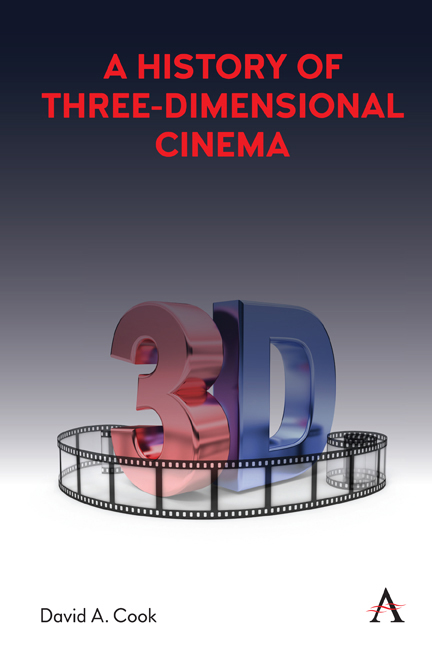Book contents
- Frontmatter
- Dedication
- Content
- List of Figures
- Acknowledgements
- Prefatory Note/Introduction
- 1 “A New Way to Simulate Presence”: The Foundations of Stereoscopic Entertainment, 1427–1888
- 2 “A Very Vivid Impression of Movement”: Early 3D Cinema, 1895–1952
- 3 “See It in 3 Dimension!”: The First Hollywood 3D Boom, 1952–55
- 4 Stereoscopic Revival, 1970–85
- 5 The Age of IMAX, or the “Immersive Cinema,” 1986–2009
- 6 The Blockbuster Years: Digital 3D, 2010–20
- 7 “A Different Kind of Mental Image”: Some Aesthetic Considerations about 3D
- 8 “Experience on Demand”: Virtual Reality
- 9 Conclusion
- 3D Discography: Discs Viewed or Sampled in Preparation for This Book
- Selected Bibliography
- Index
4 - Stereoscopic Revival, 1970–85
Published online by Cambridge University Press: 22 October 2021
- Frontmatter
- Dedication
- Content
- List of Figures
- Acknowledgements
- Prefatory Note/Introduction
- 1 “A New Way to Simulate Presence”: The Foundations of Stereoscopic Entertainment, 1427–1888
- 2 “A Very Vivid Impression of Movement”: Early 3D Cinema, 1895–1952
- 3 “See It in 3 Dimension!”: The First Hollywood 3D Boom, 1952–55
- 4 Stereoscopic Revival, 1970–85
- 5 The Age of IMAX, or the “Immersive Cinema,” 1986–2009
- 6 The Blockbuster Years: Digital 3D, 2010–20
- 7 “A Different Kind of Mental Image”: Some Aesthetic Considerations about 3D
- 8 “Experience on Demand”: Virtual Reality
- 9 Conclusion
- 3D Discography: Discs Viewed or Sampled in Preparation for This Book
- Selected Bibliography
- Index
Summary
Renewal attempts
There were several stabs at a 3D revival during the 1960s before the 1970s surge in soft-and hardcore pornography stimulated by the scrapping of the Production Code and implementation of the CARA (Code and Ratings Administration) system in October 1968. September Storm (Byron Haskin, 1960), independently produced by Edward Alperson and distributed by Fox, was the only film associated with the 1950s boom that was released in both Natural Vision 3-Dimension and CinemaScope, as well as in Eastman Color with prints by De Luxe, but it apparently wasn't filmed with anamorphic lenses as were contemporaneous features bearing the “CinemaScope” trademark. According to Bob Furmanek, who supervised the 3D Film Archive restoration in 2016, September Storm was shot full-frame using the same aspect ratio as Bwana Devil and House of Wax (1.37:1) and then extracted in postproduction to create optical prints for 2.39:1 anamorphic projection in a process similar to RKO's SuperScope (see Chapter 3). Shot on location in and around the Spanish island of Majorca, the film is a seabound adventure about a search for sunken treasure that nevertheless features impressive 3D interiors and some stunning underwater sequences; it opened in 3D in a number of major cities in September but was released flat elsewhere (Figures 4.1 and 4.2). The following year, Warner Bros. released the independently produced Canadian film The Mask (Julian Roffman, 1961), a fairly conventional black-and-white 2D horror thriller with wildly creative anaglyphic 3D dream sequences. The story revolves around an ancient mask, modeled on a real one used in Aztec peyote ceremonies, that causes the wearer to hallucinate murderous visions from the unconscious mind. The director had originally signed legendary Hollywood montage artist Slavko Vorkapich to design these sequences, but his script proved too expensive for the film's relatively modest budget (although he still got screen credit for it), and Roffman ended up directing them himself to create a psychedelic, occasionally disturbing viewing experience. Although they were part of a William Castle-like audience participation gimmick in which spectators were given “Magic Mystic Masks” (anaglyphic 3D glasses) to see them, Roffman himself regarded the film as an avantgarde experiment, which extended to the use of electronic music composed by Myron Schaffer and Louis Applebaum to underscore its surrealistic 3D images.
- Type
- Chapter
- Information
- A History of Three-Dimensional Cinema , pp. 61 - 80Publisher: Anthem PressPrint publication year: 2021



